

Sage Barista Touch Impress review: my gateway to the world of coffee
What was I thinking? For the longest time, I drank my coffee from a fully automatic machine. Now that the Sage Barista Touch Impress has brought that chapter of my life to a close, I’m ready to embrace the heady delights of the coffee world.
This review was inspired by none other than Simon Balissat, the editorial team’s resident coffee nerd. No matter where he travels, he’ll always take along a bag of special coffee beans from some off-the-beaten-track roastery. As for the fully automatic coffee machine in our office, which keeps the marketing department topped up with free caffeine, he snubs it as a matter of course. I do the opposite. My espresso consumption averages 1-3 cups a day. Until now, all that mattered to me was being able to get my drink quickly. A need that made me dependent on automatic machines, both at the office and at home.
Maybe Simon thought I was a hopeless case. He once took me to a hipster coffee bar in Zurich, to no avail. But when Sage, an Australian manufacturer of small kitchen appliances gave us the chance to test the Barista Touch Impress, he decided to take another shot at converting me. «Why don’t you test the machine?,» he said, pointing out that it was basically the next natural evolutionary stage of coffee preparation. A portafilter machine for dummies. I agreed. And as it turned out, a three-stage process turned me into a better coffee drinker.
Phase 1: scepticism and trepidation
We’ve had a De’Longhi Dinamica Plus in our kitchen at home for years. Until now, it’s been faithfully churning out my espressos, my wife’s morning cappuccinos and my daughter’s babyccinos and milk for hot chocolate. We chose it because it was slim, had a removable milk tank and didn’t ask many questions; instead dispensing coffee at the touch of a button.
The Barista Touch Impress, on the other hand, demands respect. For the first couple of days, the box stays put in the basement. It has a lot of accessories that I, as a portafilter novice, don’t know the name or purpose of. I’m slightly scared of it. At 30 centimetres wider, it’s also significantly larger than my De’Longhi. How will it impact the look of the kitchen?
I mentally prepare myself for the change by reading the manual (something I very rarely do) and watching YouTube videos of guys like Simon (coffee snobs) trying to explain the basics of portafilter technology. This turns out to be a mistake – at this point, my sense of dread is even greater.
Phase 2: tinkering and testing
Dread or no dread, I’ve already agreed to test the machine. I’ve got no choice but to unbox and set it up. This is when I get my first pleasant surprise. At 30 centimetres, the Barista Touch Impress is wider, but less deep than the De’Longhi machine. There’s even slightly more space on the worktop than before.
I then take a look at the individual components. Inserting the filter into the water tank is tricky. Though clever in itself, the handle/cover construction on the tank kind of gets in the way, and doesn’t seem particularly stable. Fortunately, you only need to replace the filter every three months.
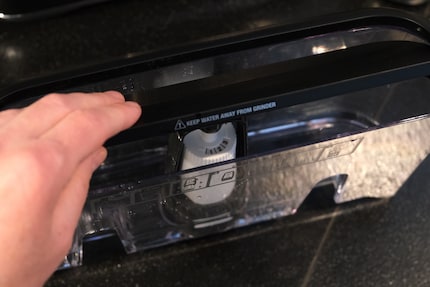
Source: Martin Jungfer
My next step is to pull out the drip tray and take off the adhesive strips that allow the machine to be transported safely. Behind this, there’s an additional compartment containing descaling tablets, a small brush and a puck razor (a kind of scraper used to remove excess coffee grinds). I’m glad Sage has thought to make intelligent use of the space inside the machine.
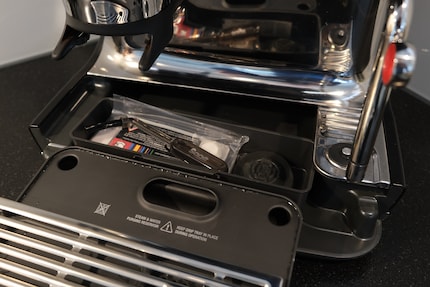
Source: Martin Jungfer
With the stickers removed and water in the tank, all I need now are some coffee beans. The manual and a flyer tell me the same thing Simon’s been preaching to me for a long time: beans printed with a best-before date should, at best, be your second choice. I’m urged to fill the bean container with beans that have a roasting date, and to use them as soon as possible. Okey-doke, then. A Kimbo roast inspired by Italian Autogrill espressos seems to fit the bill.

I put about two handfuls of beans into the container above the grinder, which is equipped with 30 levels. When closed, a rubber ring ensures the container is almost airtight. According to the instructions, you need 18 grammes of ground coffee beans for one double espresso. Significantly more than when making capsule coffee or using a fully automatic machine, which require 8 and 6 grammes respectively.
Having sorted out the beans, I press the power button for the first time and bring the machine to life. The colourful display greets me with a milk art illustration, then asks me to adjust a few settings. I choose a language and my preferred kind of milk (oat). Sage has equipped the Impress with the manufacturer’s clumsily named «MilQ» feature. This ensures the milk or milk alternative you’ve selected are heated and frothed at the right temperature. Cow’s milk can withstand higher temperatures than alternatives made from oats, soy or almonds. Most fully automatic machines, however, treat milk alternatives the same as cow’s milk. The result? Some fairly sad-looking dregs undeserving of the title of milk foam.
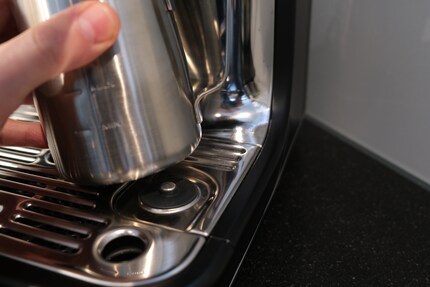
Source: Martin Jungfer
The machine tells me it’s «ready» and guides me step-by-step towards my first coffee. A note on the screen tells me it’ll take about ten minutes. Precisely what I was just wondering. After that, a picture marked with the machine’s key parts appears on the display. These include the tamp lever, grinding cradle, portafilter, water spout, group head, steam wand and grind size adjustment dial. Though all of this is obvious to portafilter pros, they’re key fundamentals for me.

Source: Martin Jungfer
I then learn the difference between dual-wall and «regular» filter baskets. Four of these inserts come included with the Barista Touch Impress. The dual-wall variety is for pre-ground or older beans, while the other baskets are for fresh beans. Each type comes in a 1-cup and a 2-cup version.

Source: Martin Jungfer
It’s time for my first attempt at grinding beans. All I’ve got to do is place the portafilter with the appropriate basket under the grinding cradle, press the button and hey presto. The Sage grinds about one gramme of beans per second, which is surprisingly slow. My fully automatic machine was faster. The grinding process stops automatically, at which point, the screen tells me to tamp. I push down the lever on the side twice. The display prompts me to add beans, so I press the button and tamp again. Then, I do the same thing two more times until the machine’s satisfied.
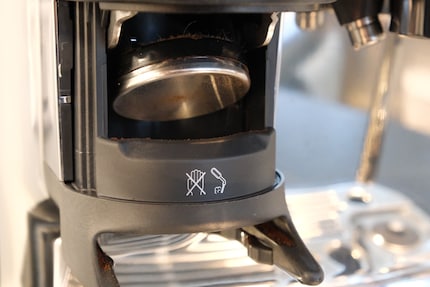
Source: Martin Jungfer
I can then clamp the portafilter containing the puck I’ve created myself to the group head. This is the part that makes me feel like a barista. My rational mind, however, knows I’ve simply taken on a small part of the work my fully automatic machine used to do for me. But it doesn’t matter. I still feel needed.
Another tap of the screen kicks off the coffee-brewing part. It only takes a few seconds for the hot water to be mixed with the freshly ground coffee. On the screen, a stopwatch counts the seconds. Once the espresso’s been poured into the cup, the machine says there’s potential for improvement. Apparently, the grind size was too large and the extraction too slow. I adjust the grind size using the dial on the side and try again. This time, the machine’s happy. As am I. My first espresso! I feel slightly proud to have made it. Even if all I did was follow the instructions on the display.
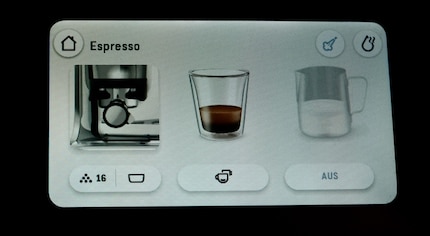
Source: Martin Jungfer
Phase 3: optimising and tasting
It’s handy that the machine remembers the amount of coffee once it’s been ground. As a result, you’re spared the additional rounds of tamping and button-pressing when you make your next cup of coffee. Since the device optimises itself, I decide to do some self-optimisation of my own. This leads me to buy some extra accessories, the first being a little «knock box» for excess coffee grounds, placed next to the machine. If I hadn’t, I probably would’ve broken the plastic bin we use for organic waste, where I threw my used coffee pucks during the first few days.
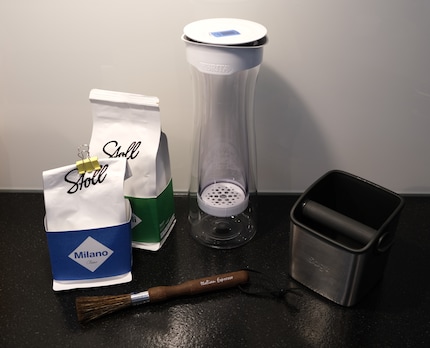
Source: Martin Jungfer
I also buy myself a brush to remove any excess powder from the portafilter after tapping it on the knock box. Since my tap water is pretty chalky, I buy a water carafe to filter it. This’ll make the machine last for longer. Despite regular descaling, the machine will inevitably build up limescale deposits – one of the most common causes of problems.


Bürstenhaus Redecker Espresso brush

And I haven’t even got started on the coffee beans yet. I now understand what Simon was talking about when he described my Italo roast as «burnt». Now that I have a machine that extracts the flavour from the beans, I’m more able to taste these nuances. I’m taking my first tentative steps into a world that was previously unknown to me. At the moment, I’m testing the beans from Zurich-based roaster Stoll.
As every bean variety is different, the machine keeps having to relearn how much coffee it needs to grind for the portafilter to fit correctly. So, whenever I change beans, the first two or three coffees will either go through the machine too slowly or too quickly.
Foam for (almost) every milk
As well as different coffee beans, I also test different types of milk. Cow’s milk with a 3.8-per-cent fat content is no match for the Impress. Using its four jets, the steam nozzle creates fluffy, ever-so-slightly porous foam in less than half a minute in the stainless steel jug included with the machine. The sensor underneath ensures the milk reaches (but doesn’t exceed) the intended temperature of 70 degrees. Admittedly, though, the machine doesn’t come close to professional barista foam.
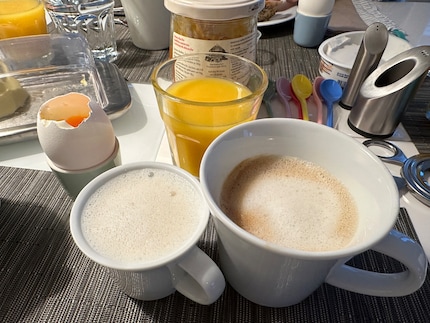
Source: Martin Jungfer
If I tap the oat milk setting on the screen, a nice little symbol pops up and displays the target temperature of only 60 degrees. It’s worth bearing in mind that plant-based milk is generally less easy to froth. It just doesn’t have the protein compounds necessary for foam that are contained in animal milk. The exception is soy milk, which is most similar in chemical structure to cow’s milk. Soy or rapeseed oil is often added to milk made from oats, almonds, coconut or rice. Sometimes, it also contains lecithin. This makes it easier to foam and more marketable as a «barista edition».
When I test the milk-foaming feature on the Sage Impress using Oatly oat milk, the results are impressive. The foam may not be quite as fine-pored as that of cow’s milk, but it’s strong and fluffy.
Although «MilQ» sounds like some kind of smart technology, it turns out it just regulates the maximum temperature of the milk according to its type. Something you, the user, need to tell the machine in advance. If you ask me, the marketing hacks have been a little overzealous with choosing a fancy-sounding name.
Is a fully automatic coffee machine a viable alternative?
Thanks to the Barista Touch Impress, I have the illusion of being able to prepare a portafilter coffee. I know I still have a lot to learn before Simon, the editorial team’s barista-in-chief, takes me seriously. But I’ve taken that first step, and even enjoyed doing so. The step-by-step, on-screen instructions are better than any I’ve seen on other devices or associated apps. Well done, Sage!
The version I tested (in the colour «black truffle») costs (as of January 2024) just under 1,200 Swiss francs or euros. In this price range, you can, in theory, get fully automatic machines that make decent coffee too. At least, in my opinion. Simon would disagree. The Siemens EQ9, for example, has a good rating on Galaxus. What’s more, you can control these devices with an app and integrate them into your home network. I was able to do the same with my old De’Longhi machine, although I never used it. What’s the point of being able to switch the machine on via an app when I still have to position the cup and top up the beans myself? With this in mind, the lack of an app for the Sage Impress Touch doesn’t make me feel like I’m missing anything. To get that real barista feeling with a steep learning curve, you could also go for a combination grinder and portafilter. They fall within a similar price range, and you’ll still have enough budget for gadgets.
The only criticism I have of my new Sage machine’s finish and functionality is of little details. Being installed at the back, the water tank is pretty difficult to access. Positioning the espresso cups under the spout correctly is also a challenge – especially when you’re just starting out. As you can see in the video below, even master barista Simon had a coffee spillage because of this.
Will I ever go back to my fully automatic coffee machine? In short, no. I was surprised that the Barista Impress Touch can make so much better-quality coffee out of the same beans. Evidently, the machine components and the beans work well together. And thanks to the truly outstanding milk-frothing nozzle, I’ve gone back to regularly treating myself to cappuccinos.
In a nutshell
Best gateway to the barista game
Pro
- stores personalised coffee recipes you’ve created
- froths milk perfectly, even when using plant-based alternatives
- large, bright display
- smart solution for storing accessories
- compact, well-executed design
Contra
- no Wi-Fi connection, no app
- fresh water tank is difficult to remove and fill
- nigh on impossible to position small espresso cups under the spout accurately: mess alert!
Journalist since 1997. Stopovers in Franconia (or the Franken region), Lake Constance, Obwalden, Nidwalden and Zurich. Father since 2014. Expert in editorial organisation and motivation. Focus on sustainability, home office tools, beautiful things for the home, creative toys and sports equipment.



